Home
A comprehensive resource for safe and responsible laser use

If you are writing a laser law...
If you are a regulator who wants to restrict some laser uses or limit access to certain types of lasers, a good place to start is New Zealand’s “Options to Manage the Health and Safety Risks from High-power Laser Pointers.” This November 2012 consultation document summarizes the problem, and proposes various approaches to regulation. (The final New Zealand law, announced December 2013, is described here.)
Below are additional suggestions and points to consider.
Lasers vs. laser pointers
Be clear whether your law applies to lasers or "just" laser pointers. Lasers are devices that emit ultraviolet, visible or infrared light due to a process called "stimulated emission." Laser pointers are a subset of all lasers. They almost always emit visible light (not UV or IR), they are usually of reasonable handheld or pocketable size, and they usually run only on batteries.
In the United States, there has been a further distinction made by the FDA/CDRH: "Laser pointers are handheld lasers that are promoted for pointing out objects or locations." Under this interpretation, if a handheld laser is promoted for non-pointing purposes (popping balloons, lighting matches), it is technically not a laser pointer. (See the Rules for U.S. sellers page, and the section “FDA/CDRH reinterpretation of SLA lasers: for a Feb. 2011 update on CDRH’s definition of laser pointers.)
Suggested definition of a laser
If you want to protect aircraft, vehicles or people from unwanted laser light, it is best to use "laser" in your definition. This will include all lasers: pointers, handhelds, scientific lasers (such as astronomical telescope guidestars), communications lasers (for free-space and satellite links), and light show lasers. That's because during an incident, it doesn't matter what type of laser creates the bright light. Also, people should be protected from invisible ultraviolet and infrared light when it is powerful enough to exceed the Maximum Permissible Exposure (MPE) limit. Usually laser pointers do not emit this type of light, while other types of lasers can do this.
A simple, accurate definition of laser is "a device that emits a beam of ultraviolet, visible or infrared radiation due to stimulated emission." Note in this definition we are including a "beam" since usually it is the light from a beam that is at issue (a few lasers can emit a wide cone or a plane of light).
Suggested definition of a laser pointer
One way to try to reduce laser misuse incidents is to restrict the sale and/or possession of certain types of lasers. (Note that this may or may not be effective.)
Because it is not practical to ban or register all lasers, usually it would be sufficient to try to restrict access to "laser pointers". That's because the vast majority of incidents occur when ordinary citizens misuse these pen-like devices.
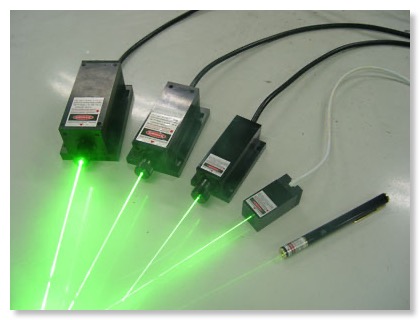
These are all small, portable lasers. The four blocky modules (the ones with wires) are usually sold for scientific, industrial and lightshow use, although they are also readily available on the Internet to laser enthusiasts. Most misuse incidents are caused by self-contained pen- or flashlight-style battery-powered lasers such as the one in the lower right corner. If laser modules begin to be involved in more incidents, then regulatory efforts may need to expand to include modules.
One workable definition is: "a laser pointer is a battery-powered portable handheld device that emits visible laser light." This is sufficient to include most pen- and flashlight-style laser pointers sold to the general public. Small industrial, scientific and lightshow lasers are usually not battery-powered, are often fixed to a base or inside equipment, and usually are not shaped or designed to be comfortably held in one's hand. Lasers that emit only invisible ultraviolet or infrared light are exempted since these aren't usually sold as pointers (the light is invisible!) and they can't cause visual interference such as glare or flashblindness.
Note that this definition would include handheld laser levels and distance measuring devices.
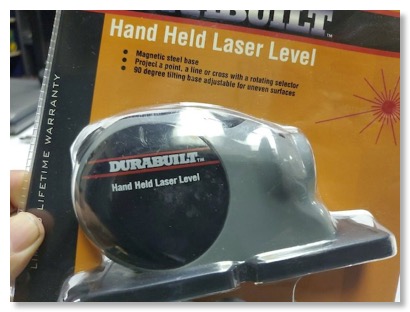
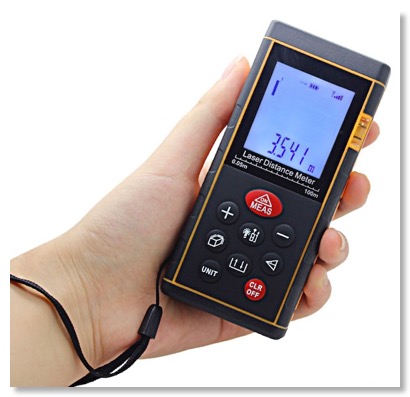
In a document published August 12 2017, the U.K. government gave the following definition of a laser pointer: “Laser pointers are generally small battery-operated hand-held devices that emit a tightly focused beam of light that is concentrated into a very small area, even over long distances. Lasers can come in a variety of designs, emitting different coloured laser beams and at varying powers. Laser pointers were originally developed to help presenters point out key features on a screen (hence the term laser pointer).”
In the U.K. Laser Misuse (Vehicles) Act 2018, which received Royal Assent on May 10 2018, the term “laser beam” is defined as “a beam of coherent light produced by a device of any kind.” The Act prohibits shining or directing a laser beam at vehicles, air traffic facilities or air traffic controllers. It does not matter whether the beam comes from a laser pointer or some other type of laser beam-producing device.
In a 2019 ban on all laser pointers above Class 1, Switzerland defined "laser pointer" as "a hand-held laser that can be used to point to things, for amusement (as a toy or in hobbies), to scare off animals or drive away other people."
Exempt laser pico projectors
Unfortunately, sometimes a simplistic definition of a laser pointer -- something that emits laser light -- would include a laser pico projector. This is a cellphone-sized consumer device that uses laser diodes to project a video image.
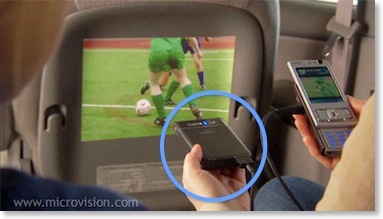
Artist's concept of a laser pico projector (circled) in use. It emits laser light, but the light spreads out so fast and is so relatively dim, that it is not a hazard to eyes or aircraft. Because of this, it should be exempt from some regulations that are more appropriate for lasers with thin beams.
Fortunately, the laser light from a pico projector spreads out so fast that its irradiance at any reasonable distance is not a visual hazard. For this reason, a better definition is one of the following:
- General: "A laser pointer is a battery-powered portable handheld device that emits visible laser light in a narrow beam. Laser pico projectors and other high-divergence laser light sources are not included in this definition."
- More specific: "A laser pointer is a battery-powered portable handheld device that emits visible laser light with an irradiance greater than 5 microwatts per square centimeter (5 µW/cm²) at all distances beyond 500 feet." The numbers are derived from the FAA's Critical Flight Zone. Five microwatts per square centimeter does not interfere with pilot vision -- it does not cause glare or flashblindness. 500 feet represents the minimum altitude for aircraft in the U.S.
New Zealand definition of a high-power laser pointer
In December 2013, New Zealand enacted a law restricting laser pointers above 1 milliwatt. A high-power laser pointer is officially defined as a device that:
(a) in the Director-General of Health’s opinion, is of the kind commonly known as a laser pointer; and
(b) is battery operated; and
(c) is designed or intended to be operated while held in the hand; and
(d) produces a coherent beam of optical radiation of low divergence*; and
(e) has a power output of greater than 1 milliwatt (mW).
*Note: A coherent beam of optical radiation of low divergence means a beam that does not fan out like a torch beam.
The wording “optical” radiation appears to mean visible light (as opposed to non-visible infrared or ultraviolet light).
Western Australia definition of a laser pointer
The Radiation Safety (General) Regulations 1983 define a laser pointer as follows:
(4) In this regulation —
laser pointer means a laser for —
(a) pointing at objects or images; or
(b) recreation or amusement.
Michigan definition of “directed energy weapons”
In May 2017, Michigan passed a law prohibiting intentionally aiming directed energy weapons at aircraft, the path of aircraft, or at a moving train. The law has this definition:
"Directed energy device" means any device that emits highly focused energy and is capable of transferring that energy to a target to damage or interfere with its operation. The energy from a directed energy device includes the following forms of energy:
-- Electromagnetic radiation, including radio frequency, microwave, lasers, and masers.
-- Particles with mass, in particle-beam weapons and devices.
-- Sound, in sonic weapons and devices.
This is an interesting approach, since it puts lasers into a class of other devices that could harm pilots or electronic controls.
Additional definitions
Additional definitions of “laser pointer” can be found on the pages that list International laws and U.S. laws. Scroll through each page, looking for definitions.
Information about various jurisdictions’ laws on exemptions, or on how to get laser pointer permits and imports, can be found here.
Exempted laser pointers: Less than 1 mW or 5 mW?
If a laser pointer ban or restriction is necessary, it should apply only to brighter lasers. The U.K. and U.S. both recognize this principle. The U.K. allows importation of pointer-type lasers only if the light output is less than 1 milliwatt, or "IEC Class 2". In the U.S., the CDRH only allows lasers to be sold for pointing if they are below 5 milliwatts; this is IEC Class 3R (old U.S. Class IIIA).
Lasers with powers below 1-5 mW work fine for most pointing purposes. The main reasons that more than 1 to 5 milliwatts may be necessary for pointing applications is 1) to easily see the laser “dot” in bright light, as in a daytime construction site and 2) to see a beam in mid-air at night, as in pointing out stars for astronomy purposes.
Over the entire range of laser powers, there is relatively little difference between the injury potential of 1 or 5 milliwatts (see the top chart on this page). For almost all practical public health purposes, either 1 or 5 mW will work as a reasonable, safe limit.
Therefore, it is suggested to exempt laser pointers that are IEC Class 2 or lower (to be more conservative, as in the U.K.), or to exempt laser pointers that are Class 3R or lower (to be more lenient, as in the U.S.). This will allow reasonable use, while restricting or banning higher powered pointers that have much greater potential for misuse.
How to handle misuse of a 1 mW or 5 mW laser
A 1 mW or 5 mW laser pointer, while low-powered, is not "safe" in all circumstances. It can cause visual interference with drivers, or with pilots at low altitude. For example, a 5 mW laser pointer can flashblind to a distance of about 260 feet, and can cause glare to a distance of about 1200 feet. A man was jailed in the U.S. for using a 3.3 mW laser pointer against an aircraft.
Because of this there should also be a ban on deliberate aiming of any laser -- of any power or type -- to track, target or interfere with an aircraft. This is discussed below at more length.
Note the important difference between making products illegal and making misuse illegal. In some cases, restrictions on sale or possession of certain types of laser pointers may be justified. But this should not be so broad as to include even low-powered pointers, or safe devices such as laser picoprojectors. If legal, low powered pointers are misused, this can be addressed by separate regulations against the misuse per se. This is analogous to allowing the sale of knives of reasonable length, but 1) making switchblades and swords illegal while also 2) making assault with any knife illegal.
When a broader definition is useful
The above definitions of "laser pointers" are best when trying to reduce the general public's access to the most common types of lasers that are misused. However, there may be times when a broader definition is required.
For example, LaserPointerSafety.com has suggested putting a warning label on small lasers, warning the user not to point it at or near aircraft. Such a label costs manufacturers very little, and does not interfere with legitimate use or possession of a laser. So it is OK in this case to include more than just laser pointers in the definition.
LaserPointerSafety.com suggests the following lasers should be required to have an Aviation Safety Label: "An IEC Class 3 or Class 4 laser, under 15 inches in longest dimension, that emits visible laser light." LaserPointerSafety.com's full definition does have some exemptions, such as for picoprojectors. Contact LaserPointerSafety.com for a copy of the complete Aviation Safety Label proposal.
A laser-restriction law that was vetoed
A 2013 New Jersey bill to ban the sale of laser pointers over 1 milliwatt, passed by the legislature 106-8, was vetoed by Governor Chris Christie. His reasons for the ban were interesting.
Gov. Christie noted that the New Jersey bill would have gone “well beyond” the federal government’s 5 milliwatt limit for laser pointers. He said there was no criminal use of lasers between 1 and 5 mW in New Jersey. Christie indicated the bill was “arbitrary” and interfered with lawful commerce of pointers typically used in business presentations.
More details, and the full text of his veto, are here.
Preventing “sawed-off lasers” and “harvesting”
When regulating lasers, it is important to carefully and clearly define words such as “portable” and “handheld”. LaserPointerSafety.com suggests that a laser with its longest dimension less than 15 inches is portable and hand-holdable.
And just as important, the law must state that the laser components inside cannot be easily removed. For example, if a small laser module is inside a larger housing, it is easy to cut the housing so it is shorter, or remove the laser module and wire it to a battery.
A significant incident occurred in June 2010, with laser diodes being harvested from an otherwise safe projector. The Casio Green Slim series of data projectors are sold for businesses to project computer video such as PowerPoint slides in a meeting room.
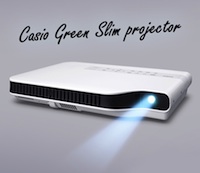
Casio Green Slim projectors contain 24 laser diodes as the light source. If you turn one on its back, bypass the cover interlock, and tilt up the block of diodes, you get a fist-sized beam array of twenty-four 650 milliwatt (0.65 watt) beams. Each beam is the most hazardous laser classification, Class 4. Seeing such an array in action is frankly scary. Here is a photo:
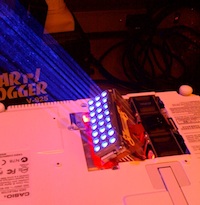
Photo credit: Patrick Daniel Murphy
This array caused duct tape to smolder in just a few seconds.
Unfortunately, the diodes are simply soldered in. They are easily removed and can be made into small pen-sized laser pointers emitting 1 watt of blue light. This shows a roomful of Casio projectors, purchased to harvest the diodes and turn them into 1-watt laser pointers. There are roughly 20 stacks visible, with at least 20 projectors per stack, and 24 diodes per projector. So this room could supply about 10,000 1-watt laser pointers.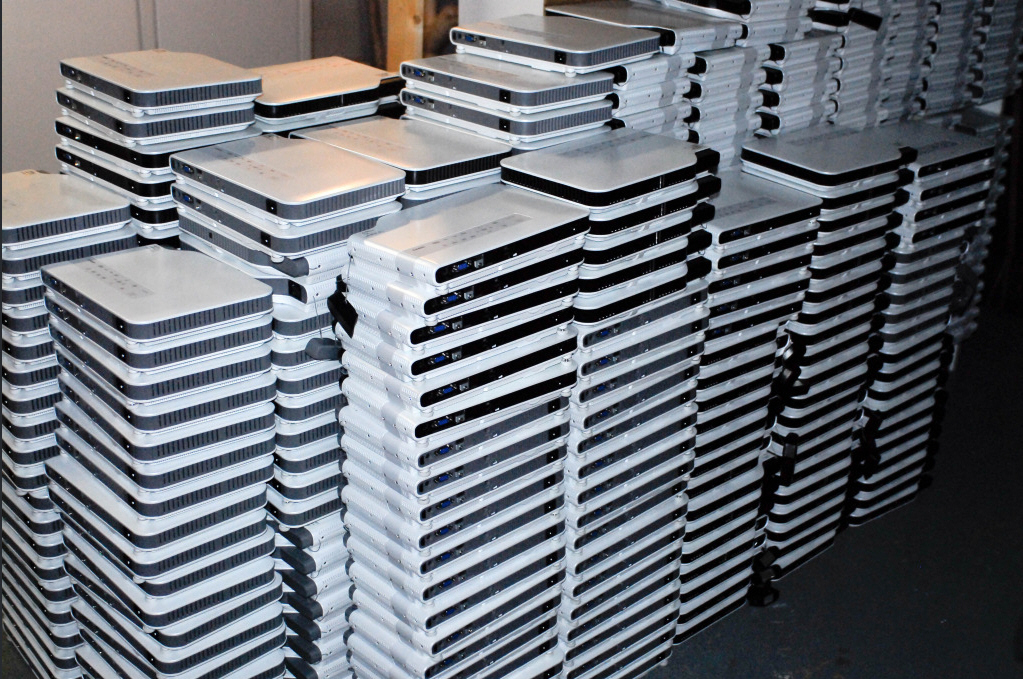
One blue diode previously (prior to 2010) sold for $3000 in single quantities, so it was not affordable by most persons. But Casio Green Slim projectors sold for around USD $800. Thus, the harvested diodes cost 800/24 or just $34 each. Adding a battery and a driver circuit that increases the power to 1 watt brings the parts cost up to about $100. On June 9, 2010, Wicked Lasers began using harvested Casio diodes to make their Spyder III Pro Arctic 1 watt portable blue laser, which they sell to the public for $300. As described here, the Spyder III Pro Arctic is a hazardous Class 4 laser.
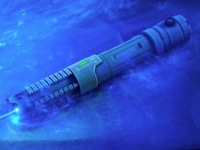
The main point of this page about making laser laws, is that any regulations must also prevent easily removable lasers or components because they WILL be removed and repurposed. The wording needs to be clear and effective, because sometimes merely adding a lens or other simple component can turn a device from impractical, to highly desirable and dangerous.
Defining laser interference with aircraft
Currently, the number one hazard of laser misuse is deliberate aiming of lasers at aircraft. It may seem easy to make it illegal to point a laser at an aircraft. However, there are significant problems with such a simple approach:
- Laser light goes on forever. If a person in an urban area aims a laser into an apparently empty part of the sky, there may be an unseen -- and unaffected -- airplane many dozens of miles away. And given how fast aircraft travel, even if there is not an airplane at this second in the beam, there might be one close to the beam in another five or ten seconds. So a person may be in technical violation even if the sky looks to be free of aircraft and even if the light level is very low by the time it reaches the aircraft.
- There are many legitimate reasons to aim lasers into the sky. Fortunately, legitimate users almost always take responsible actions to avoid hitting aircraft. For example, FAA routinely does not object to laser light shows that emit beams with an irradiance far beyond FAA limits, as long as FAA is notified in advance and aircraft spotters are used to shut off the beam if an aircraft comes near.
- The FAA does allow some levels of laser light in the sky. They have established limits for laser light brightness in various areas such as runways and approach paths. If a beam's irradiance is below this limit, then the FAA considers that pilots should be able to handle the acceptable laser light level.
For this reason, LaserPointerSafety.com advocates a two-part approach:
1) For deliberate exposures, ban deliberate aiming or tracking. A person should not deliberately track, aim at, or interfere with aircraft. It does not matter if the beam actually hits the aircraft. The mere act of tracking/aiming should be illegal except under legitimate exemptions such as FAA- and DOD-approved laser operations, and when signaling aircraft in a rescue situation.
2) For accidental or negligent exposure of aircraft, LaserPointerSafety.com suggests two conditions. Both of these have to be met in order to be a violation: A) The calculated or measured beam irradiance at or in the immediate vicinity of the aircraft is above FAA-set limits for the FAA flight zone the aircraft was in, AND B) the pilot filed an official laser incident report (Advisory Circular 70-2A) with the FAA. This way, if the pilot does not see the beam or is not bothered enough to file a report, there is not a violation. Similarly, if an accidental or negligent exposure is below FAA limits, then there is no violation.
More details are here, in a proposed U.S. law that ILDA submitted to CDRH in September 2009. And many more details are here, in an analysis of legislation introduced into the U.S. Congress. [Note that since the above was written, a law was enacted in February 2012 which made it illegal to aim a laser pointer beam at an aircraft, or the flight path of an aircraft.]
Defining other restricted behaviors
Moving vehicles: Probably the second-most hazardous misuse of laser pointers is when they are directed against moving vehicles. LaserPointerSafety.com and laser safety groups have not studied this problem nearly as extensively as aircraft incidents. However, LaserPointerSafety.com does have an initial suggestion. First, the prohibition on deliberate tracking, aiming or interfering with aircraft can be extended to moving vehicles. Second, for accidental or negligent exposure of vehicles, LaserPointerSafety.com suggests two conditions, either of which has to be met to be a violation: A) The beam must be in, on, or in close proximity to the vehicle when it is occupied, OR B) the beam must be a hazardous distraction to the driver when the vehicle is in operation. Note that waving a beam on a building when someone happens to drive by is not a "hazardous distraction". The intent is that the distraction be significant and more than just momentary.
Law enforcement and public safety officers: A number of localities ban shining a laser at an officer. This is done because the officer may think a gun's laser sight is being aimed at them. Reading through the U.S. state and local laws, you can see a number of different approaches and definitions to this serious threat. In at least one case, a man was killed because he aimed a laser at officers. Tennessee has an especially well-written statute. It has some reasonable exemptions, so that it is not illegal if the officer is off duty, or if there is no intent to "place [the officer] in fear of serious bodily injury or death." Utah also has some reasonable exemptions, such as if the officer was "not otherwise engaged in an activity that would give the [laser-using] person reason to know him to be a law enforcement officer."
Harassment: There is ample justification to ban harassment of other persons with a laser. The list of U.S. state and local laws has some example statutes which give various definitions that may be useful in defining "harassment". A definition which seems too broad is New York City's ordinance making it "unlawful for any person to direct light emitted from a laser pointer into or through a public place". A better approach would be to more specifically define annoying behavior. To give one example: "It is illegal for an audience member to use a laser to create a distraction at an entertainment event such as a movie, concert, play, or sporting event."
Notes on existing laws and definitions
In reviewing the list of international and U.S. laws, we have some additional observations. These notes may be useful when crafting your own regulations:
- A number of jurisdictions make it illegal to use "laser pointers" to interfere with aircraft or officers. Unfortunately, they then define laser pointers in a restricted way so that, theoretically, it is acceptable to use other types of lasers. See for example Arizona's statute. It only applies to devices used for "aiming, targeting or pointing out features."
- The village of Westchester, Illinois defines a laser too restrictively. They specify only helium-neon and diode lasers, although of course there are other types as well.
- Indiana, New York City and Oregon are among the jursidictions that erroneously define "laser pointer" as any device that emits visible laser light. If the intent is to cover all lasers, simply use "laser". If the intent really is to cover only pointers, then use a more restrictive definition such as those discussed elsewhere on this page.
- Texas's law against illuminating an aircraft has an interesting and useful distinction. It is a Class C misdemeanor simply to aim a laser at an aircraft. It becomes a more serious Class A misdemeanor if the "intensity of the light impairs the operator's ability to control the aircraft.” This is a commendable effort to punish truly dangerous illuminations more than merely annoying illuminations.
- A few jurisdictions such as California (section 24B), Texas and Virginia Beach, Virginia apply their "bright light" laws to both lasers and conventional lights. This is logical; it should not matter if light interference is caused by lasers or conventional lights. Also, it may strengthen the law if it is challenged in court. A law that applies only to lasers may be considered unfair or discriminatory if it does not also apply to conventional lighting with similar strength and/or effects.
- Some jurisdictions ban possession of laser pointers by persons under a certain age, usually 18. This is done partially to reduce school-related incidents, and partially to restrict youths in general as they may be less responsible than adults. Unfortunately, too many adults have been caught misusing laser pointers. For this reason, it is best to make the law apply to persons of all ages. (You can find accounts of aviation incidents caused by persons aged 20-29, 30-39, 40-49, 50-59, and 60-69. We also have accounts of non-aviation incidents caused by persons aged 20-29, 30-39, 40-49, 50-59, and 60-69.)